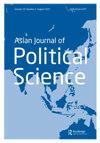China's grand strategy for Tajikistan: challenges and threats
IF 1
Q3 POLITICAL SCIENCE
引用次数: 0
Abstract
ABSTRACT Historically, Central Asia has been at an important geographical cusp wherein different civilizations such as the Indian, Chinese, and Ottoman have competed for their strategic outreach in the region. Its importance has been emphasized by Mackinder in his heartland theory. The vast discoveries of the natural resources in the region, along with the U.S. ‘War on Terror’ and China’s Belt and Road Initiative (BRI) that passes through the CARs (Central Asian Republics), have reignited the ‘New Great Game.’ Amongst the 5 CARs, the position of Tajikistan is of extreme relevance for China as it paves the way to Uzbekistan, Turkmenistan, Afghanistan, and further in Eastern Europe and West Asia. China’s strategic embrace of Tajikistan cannot be missed by the strategic experts, given its access to Xinjiang from the Taliban-dominated Afghanistan, which has led it to establish an anti-terrorism alliance with Pakistan, Afghanistan, and Tajikistan. To increase its influence on Tajikistan, China has utilized a variety of means, including soft power, investments, military help, and training programmes. In this light, the paper will attempt to examine how China rapidly brought Tajikistan under its clout and the economic, social, and strategic consequences for Tajikistan.中国对塔吉克斯坦的大战略:挑战与威胁
从历史上看,中亚一直处于一个重要的地理尖端,不同的文明,如印度、中国和奥斯曼帝国,都在争夺在该地区的战略延伸。麦金德在他的心脏地带理论中强调了它的重要性。该地区大量自然资源的发现,以及美国的“反恐战争”和中国通过中亚共和国的“一带一路”倡议(BRI),重新点燃了“新大博弈”。“在这5个国家中,塔吉克斯坦的地位对中国至关重要,因为它为通往乌兹别克斯坦、土库曼斯坦、阿富汗以及东欧和西亚的道路铺平了道路。中国对塔吉克斯坦的战略拥抱不会被战略专家错过,因为它可以从塔利班控制的阿富汗进入新疆,这导致它与巴基斯坦、阿富汗和塔吉克斯坦建立了反恐联盟。为了增加对塔吉克斯坦的影响力,中国利用了各种手段,包括软实力、投资、军事援助和培训计划。有鉴于此,本文将试图考察中国如何迅速将塔吉克斯坦置于其影响力之下,以及对塔吉克斯坦的经济、社会和战略影响。
本文章由计算机程序翻译,如有差异,请以英文原文为准。
求助全文
约1分钟内获得全文
求助全文
来源期刊

Asian Journal of Political Science
POLITICAL SCIENCE-
CiteScore
2.00
自引率
0.00%
发文量
11
期刊介绍:
Asian Journal of Political Science ( AJPS) is an international refereed journal affiliated to the Graduate School of Public Administration, Seoul National University. Published since 1993, AJPS is a leading journal on Asian politics and governance. It publishes high-quality original articles in major areas of political science, including comparative politics, political thought, international relations, public policy, and public administration, with specific reference to Asian regions and countries. AJPS aims to address some of the most contemporary political and administrative issues in Asia (especially in East, South, and Southeast Asia) at the local, national, and global levels. The journal can be of great value to academic experts, researchers, and students in the above areas of political science as well as to practical policy makers, state institutions, and international agencies.
 求助内容:
求助内容: 应助结果提醒方式:
应助结果提醒方式:


